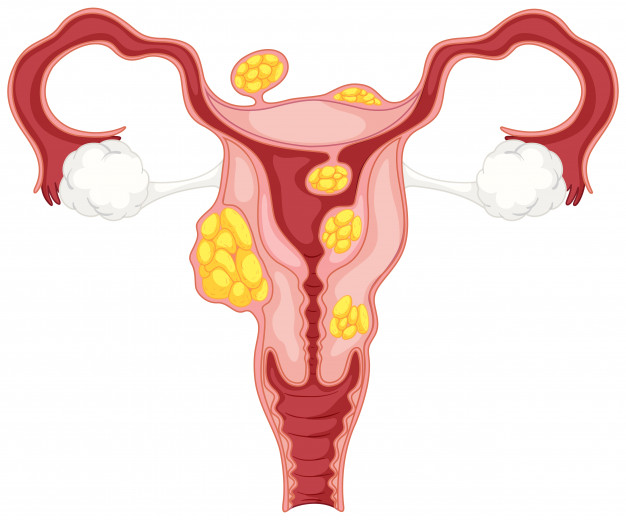Heavy Period
What is considered heavy period?
1. Need to use two pads or both pad and a tampon together.
2. Soak the pad every 1 – 3 hours.
3. Heavy bleeding for more than 7 days.
4. Passing large blood clots.
5. Need to change pads during sleep.
Heavy period can affect every day life. Also it may cause anemia resulting in weakness and fatigue, severe pain and cramps.
Causes:
1. Fibroids
2. Adenomyosis
3. Anovulation: common with young girls at the beginning of menstruation or women near menopause.
4. Polyps
5. Endometritis
6. Endometrial cancer
8. Overgrowth of uterus lining
9. Use of copper IUD
10.Thyroid diseases
11. Blood clotting disorders
12. Some medications like blood thinners
13. Uterine arteriovenous malformation. Rare
Tests:
1. Blood test to check for iron level and the underlying causes.
2. Ultrasound of uterus, ovaries and pelvis
3. Collecting cells from the uterus (endometrial biopsy).
4. Hysteroscopy: through the vagina and cervix into your uterus.
5. Sonohysterography: fluid is injected into the uterus, then check for any abnormalities in the linings with ultrasound.
Treatment options of heavy period depend on:
1. The cause of heavy bleeding.
2. Planning to get pregnant or not, as most effective treatments limit the ability to get pregnant.
3. Not having children in the future permanently or not.
If the bleeding does not cause anemia, it does not necessarily needs treatment.
It is advised to check with doctor if soaking two pads in one hour for 2 consecutive hours.
Changes in lifestyle and diet do not reduce heavy bleeding, but can ease the symptoms, like:
1. Treating underlying cause.
3. Eating food rich in vitamin C such as citrus fruits, as it helps in absorbing iron.
4. Eating food rich in iron such as beans and spinach.
A. Oral contraceptive pills.
Combination of estrogen and progestin taken for 21 days each cycle, followed by one week when bleeding happens.
Reduce bleeding and cramps.
This method may take 3 months to start showing benefits.
Hold some side effects such as nausea, breast tenderness or headache.
Combination pills are not suitable for:
a. Age greater than 35 and smoking. (more than 15 cigarettes a day)
b. Complicated valvular heart diseases
f. History of blood clots
g. Current or history of breast cancer
h. Less than 6 week postpartum
j. Liver Adenoma or hepatoma
Taken 10 to 14 days each cycle, or continuously.
Option for women prefer to avoid estrogen or who are trying to get pregnant.
It is less effective, and may cause bleeding between periods or bloating
C. IUD, releases progestin hormone.
Prevents pregnancy and reduces bleeding for up to 5 years.
Possible side effects such as irregular periods, spotting, acne (possibility of 15%), and breast tenderness.
Side effects improve in few months.
Progesterone-like hormone.
Given once every three months.
Side effect: spotting, specially in the first few months.
E. Tranexamic acid tablets (Lysteda)
It works by helping the blood in the uterus to clot.
An options for patients who are not welling to take hormones treatments.
Taken in few days per month as soon as period starts, and it does not affect pregnancy.
1300 mg three times daily for as long as five days during menstrual period.
Consult the doctor first before taking them with birth control pills as there is a risk of stroke and blood clots.
Holds some side effects but not common: headaches, tiredness and muscle cramps.
F. NSAIDs such as ibuprofen:
Less effective in reducing bleeding.
Taken only during period.
Started on the first day of bleeding and continued for 4 – 5 days.
Does not prevent pregnancy, but should be stopped upon conception as it might be associated with miscarriage and congenital anomalies.
Possible side effects: stomach problems, nausea, vomiting, headaches and drowsiness.
When the cause of heavy bleeding is fibroids.
injection given once every one to three months
Works by blocking the production of estrogen and progesterone, causing a temporary menopause, to make fibroids shrink.
It can cause hot flashes.
Not used for more than 3 – 6 months as long term use may cause bone loss.
They might be used before surgery, to shrink them and making it easier to be removed.
In addition, it is advised to take iron supplementation if anemic. The side effects are stomachache and constipation.
A. Endometrial ablation or resection: thinning or removing the lining of the uterus.
May cause nausea, vaginal discharge, cramping. Light bleeding may occur for a 2 – 4 weeks after the surgery.
If the patient got pregnant after the surgery, there is a risk of miscarriage and other complications.
– Women planning to get pregnant in the future
– The underlying cause of heavy bleeding is anovulation.
B. Removing fibroids from the wall of the uterus.
C. Uterine artery embolization (UAE):
If heavy bleeding is caused by fibroids.
Cutting off blood supply to the fibroids which makes them shrink.
D. Hysterectomy: removing uterus and cervix. It is a permanent solution.
It is an option if the other options failed or already discussed.
Longer recovery time comparing with the other procedures.



